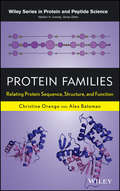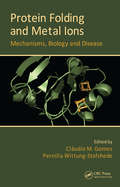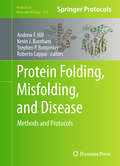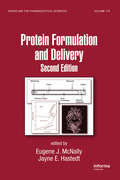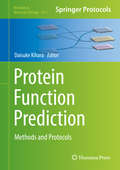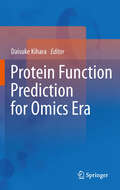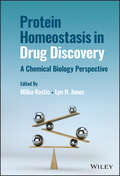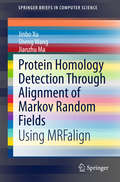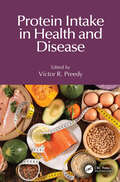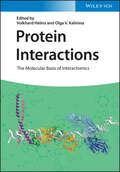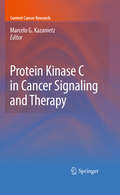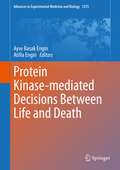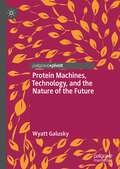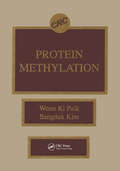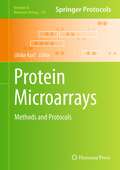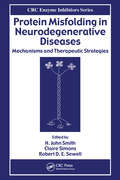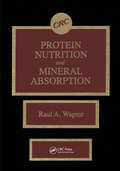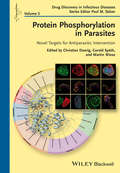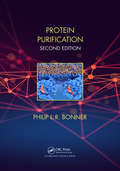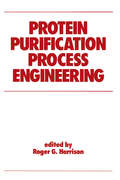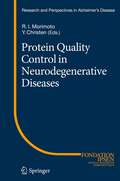- Table View
- List View
Protein Families
by Alex Bateman Vladimir Uversky Christine OrengoNew insights into the evolution and nature of proteinsExploring several distinct approaches, this book describes the methods for comparing protein sequences and protein structures in order to identify homologous relationships and classify proteins and protein domains into evolutionary families. Readers will discover the common features as well as the key philosophical differences underlying the major protein classification systems, including Pfam, Panther, SCOP, and CATH. Moreover, they'll discover how these systems can be used to understand the evolution of protein families as well as understand and predict the degree to which structural and functional information are shared between relatives in a protein family.Edited and authored by leading international experts, Protein Families offers new insights into protein families that are important to medical research as well as protein families that help us understand biological systems and key biological processes such as cell signaling and the immune response. The book is divided into three sections: Section I: Concepts Underlying Protein Family Classification reviews the major strategies for identifying homologous proteins and classifying them into families. Section II: In-Depth Reviews of Protein Families focuses on some fascinating super protein families for which we have substantial amounts of sequence, structural and functional data, making it possible to trace the emergence of functionally diverse relatives. Section III: Review of Protein Families in Important Biological Systems examines protein families associated with a particular biological theme, such as the cytoskeleton.All chapters are extensively illustrated, including depictions of evolutionary relationships. References at the end of each chapter guide readers to original research papers and reviews in the field.Covering protein family classification systems alongside detailed descriptions of select protein families, this book offers biochemists, molecular biologists, protein scientists, structural biologists, and bioinformaticians new insight into the evolution and nature of proteins.
Protein Folding and Metal Ions: Mechanisms, Biology and Disease
by Cláudio M. Gomes Pernilla Wittung-StafshedeThe role of metal ions in protein folding and structure is a critical topic to a range of scientists in numerous fields, particularly those working in structural biology and bioinorganic chemistry, those studying protein folding and disease, and those involved in the molecular and cellular aspects of metals in biological systems. Protein Folding an
Protein Folding, Misfolding, and Disease
by Andrew F. Hill Stephen P. Bottomley Roberto Cappai Kevin J. BarnhamProtein misfolding is a key feature of many disorders in humans, given that over twenty proteins are known to misfold and cause disease. In Protein Folding, Misfolding, and Disease: Methods and Protocols, experts in the field present a collection of current methods for studying the analysis of protein folding and misfolding, featuring strategies for expressing and refolding recombinant proteins which can then be utilized in subsequent experiments. This detailed volume also covers methods for analyzing the formation of amyloid, protocols for determining the size and structure of native and misfolded proteins, as well as specific examples of where misfolded proteins can be examined using state-of -the-art technologies. Written in the highly successful Methods in Molecular BiologyTM series format, chapters contain introductions to their respective topics, lists of the necessary materials and reagents, step-by-step, readily reproducible laboratory protocols, and key tips on troubleshooting and avoiding known pitfalls. Up to date and authoritative, Protein Folding, Misfolding, and Disease: Methods and Protocols offers researchers the tools necessary to move ahead in this vital field.
Protein Formulation and Delivery (Drugs and the Pharmaceutical Sciences)
by Eugene J. McNally Jayne E. HastedtThis title is intended to assist pharmaceutical scientists in the development of stable protein formulations during the early stages of the product development process, providing a comprehensive review of mechanisms and causes of protein instability in formulation development, coverage of accelerated stability testing methods and relevant analytica
Protein Function Prediction
by Daisuke KiharaGene function annotation has been a central question in molecular biology. The importance of computational function prediction is increasing because more and more large scale biological data, including genome sequences, protein structures, protein-protein interaction data, microarray expression data, and mass spectrometry data, are awaiting biological interpretation. Traditionally when a genome is sequenced, function annotation of genes is done by homology search methods, such as BLAST or FASTA. However, since these methods are developed before the genomics era, conventional use of them is not necessarily most suitable for analyzing a large scale data. Therefore we observe emerging development of computational gene function prediction methods, which are targeted to analyze large scale data, and also those which use such omics data as additional source of function prediction. In this book, we overview this emerging exciting field. The authors have been selected from 1) those who develop novel purely computational methods 2) those who develop function prediction methods which use omics data 3) those who maintain and update data base of function annotation of particular model organisms (E. coli), which are frequently referred
Protein Function Prediction for Omics Era
by Daisuke KiharaGene function annotation has been a central question in molecular biology. The importance of computational function prediction is increasing because more and more large scale biological data, including genome sequences, protein structures, protein-protein interaction data, microarray expression data, and mass spectrometry data, are awaiting biological interpretation. Traditionally when a genome is sequenced, function annotation of genes is done by homology search methods, such as BLAST or FASTA. However, since these methods are developed before the genomics era, conventional use of them is not necessarily most suitable for analyzing a large scale data. Therefore we observe emerging development of computational gene function prediction methods, which are targeted to analyze large scale data, and also those which use such omics data as additional source of function prediction. In this book, we overview this emerging exciting field. The authors have been selected from 1) those who develop novel purely computational methods 2) those who develop function prediction methods which use omics data 3) those who maintain and update data base of function annotation of particular model organisms (E. coli), which are frequently referred
Protein Homeostasis in Drug Discovery: A Chemical Biology Perspective
by Milka Kostic Lyn H. JonesProtein Homeostasis in Drug Discovery Comprehensive resource on all aspects of protein homeostasis, covering both historical perspectives and emerging technologies that are revolutionizing the field Protein Homeostasis in Drug Discovery highlights drug discovery and development efforts targeting protein homeostasis and considers the emerging appreciation that a protein’s activity may not be the only factor to consider when developing therapeutic agents. The chapters cover various aspects of protein homeostasis such as cellular localization, abundance, interactions, and more. Moreover, the text contains up-to-date information regarding targeted protein degradation, an emerging drug discovery modality. Readers interested in targeting different regulatory events that control protein homeostasis or modulating protein abundance will find this book an excellent resource. Furthermore, those interested in the link between biological function and regulating protein levels in living organisms, especially in the context of drug discovery, will learn from numerous examples discussed in this book. In Protein Homeostasis in Drug Discovery, readers can expect to find information on: Protein folding, quality control, pharmacology, and drug targeting processes Recent advances in our understanding of protein homeostasis, covering emerging technologies and opportunities for therapeutic intervention Targeted protein degradation (TPD) and strategies such as PROTACs and molecular glues, including a chapter on TPD as an antiviral drug discovery strategy Drug discovery and development efforts aimed at correcting, stabilizing, and rescuing proteins, with examples included Advantages and key shortcomings of both phenotypic and target-based traditional drug discovery methods Collectively, Protein Homeostasis in Drug Discovery offers the reader an opportunity to learn more about the importance of considering and targeting protein homeostasis. The text is a must-read resource for academics, professionals in the pharmaceutical industry, and advanced students in various science-related fields.
Protein Homology Detection Through Alignment of Markov Random Fields
by Jinbo Xu Sheng Wang Jianzhu MaThis work covers sequence-based protein homology detection, a fundamental and challenging bioinformatics problem with a variety of real-world applications. The text first surveys a few popular homology detection methods, such as Position-Specific Scoring Matrix (PSSM) and Hidden Markov Model (HMM) based methods, and then describes a novel Markov Random Fields (MRF) based method developed by the authors. MRF-based methods are much more sensitive than HMM- and PSSM-based methods for remote homolog detection and fold recognition, as MRFs can model long-range residue-residue interaction. The text also describes the installation, usage and result interpretation of programs implementing the MRF-based method.
Protein Instability at Interfaces During Drug Product Development: Fundamental Understanding, Evaluation, and Mitigation (AAPS Advances in the Pharmaceutical Sciences Series #43)
by Jinjiang Li Mary E. Krause Raymond TuProteins are exposed to various interfacial stresses during drug product development. They are subjected to air-liquid, liquid-solid, and, sometimes, liquid-liquid interfaces throughout the development cycle-from manufacturing of drug substances to storage and drug delivery. Unlike small molecule drugs, proteins are typically unstable at interfaces where, on adsorption, they often denature and form aggregates, resulting in loss of efficacy and potential immunogenicity. This book covers both the fundamental aspects of proteins at interfaces and the quantification of interfacial behaviors of proteins. Importantly, this book introduces the industrial aspects of protein instabilities at interfaces, including the processes that introduce new interfaces, evaluation of interfacial instabilities, and mitigation strategies. The audience that this book targets encompasses scientists in the pharmaceutical and biotech industry, as well as faculty and students from academia in the surface science, pharmaceutical, and medicinal chemistry areas.
Protein Intake in Health and Disease
by Victor R. PreedyProteins are fundamental to human health, serving as building blocks for cellular structures, providing essential energy, and supporting tissue function. In Protein Intake in Health and Disease, the critical biomedical and nutritional roles of protein in the diet are explored in depth. Topics include protein quality, the impact of both low and high-protein diets, and the metabolic disorders and diseases linked to protein malnutrition. The book delves into protein’s influence across the lifespan, from maternal health and early development to the nutritional needs of children, adolescents, and the aging population. Each chapter is enriched with practical insights for broader health applications and concise summary points to aid understanding.Features Contains a mini dictionary of terms and summary points in each chapter to facilitate clear understanding Highly illustrated with figures and multiple tables in each chapter Chapter contributors represent global coverage This book is written for nutritionists, food scientists, and health care professionals, as well as research scientists and practitioners. It is also practically designed for policy makers and libraries.
Protein Interactions: The Molecular Basis of Interactomics
by Volkhard HelmsProtein Interactions A fundamental guide to the burgeoning field of protein interactions From enzymes to transcription factors to cell membrane receptors, proteins are at the heart of biological cell function. Virtually all cellular processes are governed by their interactions, with one another, with cell bodies, with DNA, or with small molecules. The systematic study of these interactions is called Interactomics, and research within this new field promises to shape the future of molecular cell biology. Protein Interactions goes beyond any existing guide to protein interactions, presenting the first truly comprehensive overview of the field. Edited by two leading scholars in the field of protein bioinformatics, this book covers all known categories of protein interaction, stable as well as transient, as well as the effect of mutations and post-translational modifications on the interaction behavior. Protein Interactions readers will also find: Introductory chapters on protein structure, conformational dynamics, and protein-protein binding interfaces A data-driven approach incorporating machine learning and integrating experimental data into computational models An outlook on the current challenges in the field and suggestions for future research Protein Interactions will serve as a fundamental resource for novice researchers who want a systematic introduction to interactomics, as well as for experienced cell biologists and bioinformaticians who want to gain an edge in this exciting new field.
Protein Kinase C in Cancer Signaling and Therapy
by Marcelo G. KazanietzProtein kinase C (PKC), a family of serine-threonine kinases, rocketed to the forefront of the cancer research field in the early 1980's with its identification as an effector of phorbol esters, natural products with tumor promoting activity. Phorbol esters had long been of interest to the cancer research field due to early studies in the mouse skin carcinogenesis model, which showed that prolonged topical application of phorbol esters promoted the formation of skin tumors on mice previously treated with mutagenic agents. Research in the last years has established key roles for PKC isozymes in the control of cell proliferation, migration, adhesion, and malignant transformation. In addition, there is a large body of evidence linking PKC to invasion and cancer cell metastasis. Moreover, it is now well established that the expression of PKC isozymes is altered in various types of cancers. More importantly, small molecule inhibitors have been developed with significant anti-cancer activity. The relevance of PKC isozymes in cancer signaling is therefore remarkable. This book will have 4 sections. There will be 23 chapters. Each section will have a brief introduction by an expert in the field (~ 1-2 pages).
Protein Kinase Technologies
by Hideyuki MukaiDivided into two convenient sections, Protein Kinase Technologies collects contributions from experts in the field examining recent methodologies and techniques generally applicable to protein kinase research as well as to individual protein kinases which require special attention in neuroscience. These chapters will not only be practical instructions useful for readers' daily work in setting up and performing research but also thought-provoking and enjoyable reviews of recent advancements of individual protein kinases in neuroscience. Written for the highly successful Neuromethods series, this work contains the kind of detailed description and implementation advice that is crucial for getting optimal results. Authoritative and accessible, Protein Kinase Technologies seeks to foster cross-talk among investigators who study different protein kinases, and will also be beneficial for the entry of new investigators into this pivotal field.
Protein Kinase-mediated Decisions Between Life and Death (Advances in Experimental Medicine and Biology #1275)
by Atilla Engin Ayse Basak EnginProtein phosphorylation via protein kinases is an inevitable process that alters physiological and pathological functions of the cells. Thus, protein kinases play key roles in the regulation of cell life or death decisions. Protein kinases are frequently a driving factor in a variety of human diseases including aging and cellular senescence, immune system and endothelial dysfunctions, cancers, insulin resistance, cholestasis and neurodegenerative diseases, as well as bacterial resistance in persistent infections. Recent developments in quantitative proteomics provide important opinions on kinase inhibitor selectivity and their modes of action in the biological context. Protein Kinase-mediated Decisions Between Life and Death aims to have the reader catch insights about up-to-date opinions on “Protein Kinases” related pathways that threaten human health and life. As “Protein Kinases” are related to many health problems, clinicians, basic science researchers and students need this information.
Protein Machines, Technology, and the Nature of the Future
by Wyatt GaluskyThis book explores the relationships between humans, chickens, and environments in the context of protein production. The history of these relationships reveals them to be increasingly technological, which results in humans becoming more responsible for those animals and their environments. Understanding this development through the configuration of various kinds of protein machines is key to confronting the kinds of future we wish to promote, and the characteristics of the present we wish to sustain. The book is organized around narratives that explore the concept of the protein machine, with a particular focus on the development of the chicken as it has moved from the field to the factory to the laboratory. These transformations are interconnected, and culminate in efforts to cultivate meat without the animal. Our ultimate goal will be to ask what kind of future does this technology envision, and what roles do humans and animals play in it?
Protein Methylation
by Woon Ki Paik Sangduk KimThis significant volume provides reviews on protein methylation reactions which occur ubiquitously in nature. Written in a comprehensive style, this work covers knowledge on the natural occurrence of methylated amino acids, their chemical synthesis, plus the enzymology, biological regulator, and biological significance of free methylated amino acids. It also includes various specific biological systems where posttranslational methylation reactions have been demonstrated. This text is unique because the chapters are critically reviewed by authorities in each respective field. This well-written volume is an excellent reference to researchers as well as graduate students interested in post-synthetic modifications of macromolecules.
Protein Microarray for Disease Analysis
by Catherine J. WuProtein microarrays have been used for a wide variety of important tasks, such as identifying protein-protein interactions, discovering disease biomarkers, identifying DNA-binding specificity by protein variants, and for characterization of the humoral immune response. In Protein Microarray for Disease Analysis: Methods and Protocols, expert researchers provide concise descriptions of the methodologies currently used to fabricate microarrays for the comprehensive analysis of proteins or responses to proteins that can be used to dissect human disease. These methodologies are the toolbox for revolutionizing drug development and cell-level biochemical understanding of human disease processes. Beginning with a section on protein-detecting analytical microarrays, the volume continues with sections covering antigen microarrays for immunoprofiling, protein function microarrays, the validation of candidate targets, proteomic libraries, as well as signal detection strategies and data analysis techniques. Written in the highly successful Methods in Molecular BiologyTM series format, chapters include introductions to their respective topics, lists of the necessary materials and reagents, step-by-step, readily reproducible laboratory protocols, and key tips on troubleshooting and avoiding known pitfalls. Practical and cutting-edge, Protein Microarray for Disease Analysis: Methods and Protocols serves as a solid framework to aid scientists in understanding how protein microarray technology is presently developing and how it can be applied to transform our analysis of human disease.
Protein Microarrays
by Ulrike KorfProgress in functional proteomics has been limited for a long time, partially caused by limitations in assay sensitivity and sample capacity; however, protein microarrays have the ability to overcome these limitations so that a highly parallel analysis of hundreds of proteins in thousands of samples is attainable. In Protein Microarrays: Methods and Protocols, expert researchers in the field present an up-to-date collection of robust strategies in the field of protein microarrays and summarize recent advantages in the field of printing technologies, the development of suitable surface materials, as well as detection and quantification technologies. Written in the highly successful Methods in Molecular BiologyTM series format, chapters include introductions to their respective topics, lists of the necessary materials and reagents, step-by-step, readily reproducible laboratory protocols, and key notes on troubleshooting and avoiding known pitfalls. Comprehensive and cutting-edge, Protein Microarrays: Methods and Protocols aims to stimulate the application and further advancement of this powerful technology in labs worldwide.
Protein Misfolding in Neurodegenerative Diseases: Mechanisms and Therapeutic Strategies
by H. John Smith Claire Simons Robert D. E. SewellCurrent research suggests that neurodegenerative diseases such as Alzheimer's, Parkinson's, Huntington's, and Creutzfeldt-Jacob may be linked to disorders in protein shape referred to as protein misfolding. Continued study in this area could lead to promising advances in future treatment of these diseases. This groundbreaking text describes the latest findings regarding protein misfolding in the context of it being a marker, and perhaps a cause, in neurodegenerative diseases. Comprehensive coverage includes the diverse biochemical targets/markers for each disease, the currently limited success of drug therapies, and the cutting-edge research that could lead to more promising treatments.
Protein Modifications in Pathogenic Dysregulation of Signaling
by Jun-Ichiro Inoue Mutsuhiro TakekawaThis book is devoted to recent advances in analysis of the molecular basis and dynamics of post-translational modifications (PTMs) of proteins for a comprehensive understanding of their key roles in cell signaling networks and diverse biological processes, and their perturbation in a variety of life-threatening diseases such as cancer and inflammatory diseases. The book includes research regarding PTMs and methods of their investigation derived from interdisciplinary collaborations between leading scientists in the fields of molecular, medical, proteomic, structural, and mathematical biology. This book consists of four sections. The first part focuses on recent advances in procedures for analysis of PTMs and cell signaling. The second part is devoted to mathematical simulation of signal transduction pathways and of the formation of protein complexes in living cells. The third part deals with structural and functional analyses of proteins involved in the regulation of PTMs and cell signaling. The fourth part describes cutting-edge findings regarding critical signal transduction pathways and their dysregulation in human diseases. This book is aimed at both established scientists and students in various fields of biology including molecular, cellular, structural, proteomic, and mathematical biology. Readers can access cutting-edge research and methodologies in their own field as well as interdisciplinary research that impacts on their field. The book can function as a reference for pharmaceutical scientists, biomedical researchers, and clinicians for the development of molecular-targeted therapy of human diseases.
Protein Nutrition and Mineral Absorption
by Raul A. WapnirThis volume presents information regarding the mechanisms of protein absorption under normal and pathologic conditions, in addition to reviewing changes that occur at various stages of life. General modifiers of intestinal absorption, such as the processing of foods, the nutritional status of the individual, and disease, are explored with reference to both proteins and minerals. Inorganic macronutrients, namely calcium, magnesium and phosphorus, are discussed in relation to protein ingestion. The book also explores the concept of essential trace elements (e.g., iron, zinc, copper, and iodine) and their link to protein sufficiency. The relationship of ultratrace elements with the content of proteins in food is examined, and the book offers a fresh view of the role of certain elements, particularly zinc, on the conformation of proteins linked to DNA, hormone receptors, and gene products. Protein Nutrition and Mineral Absorption is packed with 2,300 references, 100 figures and graphs, plus 25 tables. Nutritionists and physicians will find this book to be an invaluable reference source for rationalizing nutritional interventions and diet modifications for their patients.
Protein Phosphorylation in Parasites
by Paul M. Selzer Martin Wiese Gerald Spaeth Christian DoerigThis is the first book to collect and summarize in one publication the efforts to use kinases or phosphatases for drug development against parasite infections. The editors and contributors comprise the Who is Who in the field, and they are comprehensive in covering every aspect of the topic, from basic research findings to translational approaches in drug developmentThe result will be welcomed by everyone in academia and industry participating in the global effort to finally combat the major diseases caused by eukaryotic parasites. This is volume one of a two-volume treatise, the second being exclusively dedicated to efforts to combat malaria using the same approach.
Protein Purification (THE BASICS (Garland Science))
by Philip BonnerThis second edition of Protein Purification provides a guide to the major chromatographic techniques, including non-affinity absorption techniques, affinity procedures, non-absorption techniques and methods for monitoring protein purity. The new edition of the book has been organized to encourage incremental learning about the topic, starting with the properties of water, progressing through the characteristics of amino acids and proteins which relate to the purification process. There is an overview of protein strategy and equipment, followed by discussions and examples of each technique and their applications. The basic theory and simple explanations given in Protein Purification make it an ideal handbook for final year undergraduates, and postgraduates, who are conducting research projects. It will also be a useful guide to more experienced researchers who need a good overview of the techniques and products used in protein purification. Key Features * Guide to the major techniques used in protein purification * Includes flowcharts to help the reader slect the best purification strategy * Contains step-by-step protocols that guide the reader through each technique and its use * Includes exercises and solutions
Protein Purification Process Engineering
by Roger G. HarrisonOffers coverage of the development of protein purification processes for large-scale commercial operations, and addresses process development, scale-up, applications and mathematical descriptions. Technologies currently used at the commercial scale are covered in depth.
Protein Quality Control in Neurodegenerative Diseases
by Yves Christen Richard I. MorimotoThe health of the proteome depends upon protein quality control to regulate the proper synthesis, folding, translocation, and clearance of proteins. The cell is challenged constantly by environmental and physiological stress, aging, and the chronic expressions of disease associated misfolded proteins. Substantial evidence supports the hypothesis that the expression of damaged proteins initiates a cascade of molecular events that leads to Alzheimer's disease, Parkinson's disease, amyotrophic lateral sclerosis, Huntington's disease, and other diseases of protein conformation.
